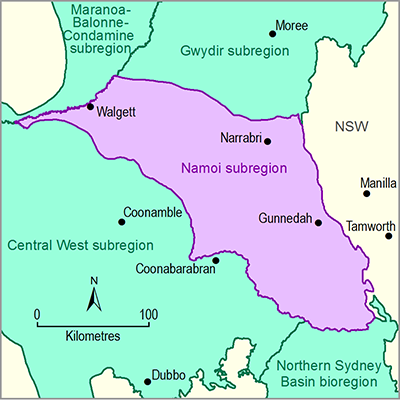Post-assessment monitoring is important to test and (in)validate the risk predictions of the assessment. At the highest level, hydrological and ecological monitoring effort should reflect the risk predictions, and focus the effort where the changes are expected to be the largest and incorporate those areas where modelling limitations did not allow the risk to be quantified. However, it is also important to place some monitoring effort at locations with lower risk predictions so as to confirm the range of potential impacts and identify unexpected outcomes.
The BA for the Namoi subregion has identified that potential hydrological or ecosystem impacts due to additional coal resource development are likely in areas concentrated around the locations of the main proposed coal resource development. Groundwater monitoring effort should concentrate on the discrete drawdown zones identified in the hydrological modelling. The following water sources have the largest number of bores where the assessment identified a drawdown of more than 2 m and would be expected to be a focus of the groundwater monitoring. In order they are:
- Gunnedah-Oxley Basin MDB
- Upper Namoi Zone 4 Namoi Valley
- Upper Namoi Zone 7 Yarraman Creek
- Upper Namoi Zone 8 Mooki Valley
- Southern Recharge
- Upper Namoi Zone 3 Mooki Valley.
Future surface water monitoring should focus on streams that pass near the additional coal resource developments, and particularly Back Creek, Merrygowan Creek, Bollol Creek and Driggle Draggle Creek, given the changes in streamflow modelled to occur there.
Besides monitoring, there are a number of data-sparse areas that would benefit from consistent and regular data collection, which would improve the risk quantification of this assessment. This includes surface water and ecological baseline data collection to establish an understanding of the environmental conditions.
There are lengths of stream that are noted as potentially impacted because risk predictions are not made in some cases (e.g. because it is not sensible to interpolate from the stream model nodes used), and where establishing data collection points and monitoring may enable additional surface water modelling, which in turn may improve the clarity around potential hydrological changes from coal resource development.
This Assessment did not model or quantify water quality changes. Existing monitoring of instream water quality is patchy in terms of spatial and temporal coverage. Where water quality impacts of coal resource development are of concern, separating these changes from the location-specific background water quality, which may include impacts from agricultural activities and infrastructure, is necessary.
The availability of ecological data for benchmarking, including identifying current conditions, comparing and identifying changes in ecosystems and ecosystem indicators, is very limited, especially for dealing with regional-level changes. There is a lack of ecohydrological understanding around the many water-dependent vegetation communities’ water requirements, and how these relate to specific hydrological response variables – a crucial requirement for assessing impacts related to hydrological changes.
The current Assessment has focused on ecosystems at the surface. This is because the understanding of the regional subsurface ecology is patchy at best and data suitable for identifying regional changes are unavailable. However, changes in groundwater and subsurface flows are likely to result in subsurface ecosystem changes and, in particular, this will relate to the hyporheic zone. The hyporheic zone is the transition zone between surface and the groundwater biota and contains the interstitial spaces that serve as refugia habitat for stream biota. It is this refugia from which they move into the streams after the drying period. This is highly relevant in the many non-permanent streams in the Namoi subregion. Work on identifying and monitoring the hydrological conditions and the limits that sustain these biota in the hyporheic zones would improve this Assessment, especially when co-located with hydrological monitoring areas.
Deeper-positioned subterranean ecosystems with their stygobiotoa respond to changes in groundwater. However, there is only limited local information available (see e.g. Korbel et al. (2013a, 2013b)), which is insufficient to provide an understanding of the hydrological determinants for stygobiota related habitat use and requirements. Groundwater biota sampling requires special sampling approaches to prevent bias in determining stygobiota composition and to achieve an unbiased picture of the subterranean ecosystems and their associated hydrological conditions (Korbel et al., 2017). This Assessment was unable to make any quantified statements related to impacts due to additional coal resource development on stygobiota. Establishing an understanding on the wider extent, compositions, structures, and hydrological habitat requirements of the stygobiota of the Namoi subregion is necessary when attempting to address risk from coal resource development. Monitoring stygobiota in association with changes in groundwater quality and quantity would be valuable in helping to address risks to this barely understood part of Australia’s ecology.

Product Finalisation date
- 3.1 Overview
- 3.2 Methods
- 3.3 Potential hydrological changes
- 3.4 Impacts on and risks to landscape classes
- 3.4.1 Overview
- 3.4.2 Landscape classes that are unlikely to be impacted
- 3.4.3 'Floodplain or lowland riverine' (non-Pilliga) landscape group
- 3.4.4 'Non-floodplain or upland riverine' (non-Pilliga) landscape group
- 3.4.5 Pilliga riverine (upland and lowland)
- 3.4.6 Potentially impacted landscape classes lacking quantitative ecological modelling
- References
- Datasets
- 3.5 Impacts on and risks to water-dependent assets
- 3.6 Commentary for coal resource developments that are not modelled
- 3.7 Conclusion
- Citation
- Acknowledgements
- Contributors to the Technical Programme
- About this technical product
